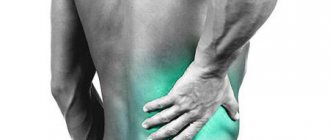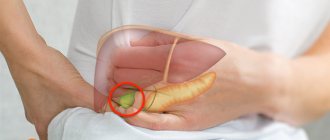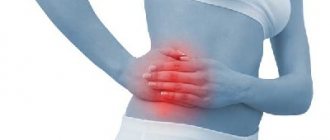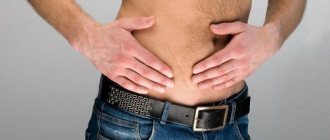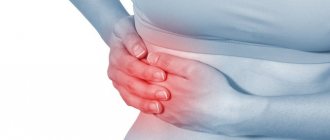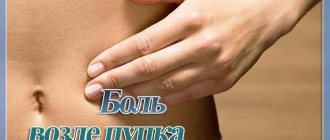What is on the right side of the abdominal cavity?
The content of the article
The abdominal cavity contains many internal organs, the stomach, intestines, pancreas, kidneys, adrenal gland, spleen, liver, pancreas, gall bladder. They are not protected, unlike the heart or lungs, by ribs. They are protected only by the muscles of the abdominal wall (abs).
Problems with any of the organs manifest themselves in the form of tingling, nagging pain and discomfort in various areas of the abdomen. If you experience periodic pain in your right side, you should consult a doctor to determine which organ has problems.
The abdominal cavity consists of 9 parts and is divided into 3 sections:
- Epigastrium
. The epigastrium itself is located directly above the navel. On the right is the subcostal region. - Mesogastrium
. Consists of the peri-umbilical and right lateral regions. - Hypogastrium
. Includes the suprapubic and right iliac region.
Due to the different anatomical structure, pain of the same nature and intensity, localized in the same place, in men and women indicates different diseases.
The following organs are located in the area of the right hypochondrium:
- flexure of the colon of the large intestine;
- right kidney (from the back);
- liver;
- gallbladder;
- right adrenal gland;
- the right half of the diaphragm (the muscle that separates the peritoneum and sternum).
Sometimes pain radiates from organs located elsewhere, for example, from the pancreas or inferior vena cava. In this case, it seems to the person that it hurts on the right side, but in fact the true cause of the pain is in another area.
Urinary tract diseases
Pain on the right side may be caused by urolithiasis. If the right ureter is affected, there may be pain on the right in the abdomen and lower back1, 2. When the stone moves, the pain on the right can move to the lower abdomen, radiate to the genitals, and the inner thighs. If the stone is located in the lower third of the right ureter, the person is bothered by a constant painful urge to urinate2, 13. The pain is usually wave-like in nature, and for spasms in diseases of the urinary tract, the use of antispasmodics, for example No-shpa®, may be indicated or No-shpa® forte7, 13, 16, 22. The passage of stone or sand from the ureter is often manifested by pain and blood in the urine13.
Causes of pain in the right hypochondrium
Pain in the right side of the abdomen does not always indicate any disease. At times they are caused by physiological changes that also happen to completely healthy people.
- Stitches in the side after jogging
or other physical activity. This is typical for unprepared people who are not used to playing sports. Physical activity is stressful for their body, and it reacts with a sharp release of adrenaline. The hormone provokes a spasm of the bile ducts, which stretch from the bile overflowing them. At the same time, the liver fills with blood, increases in size, and the organs press on each other, causing pinpoint pain and tingling. - Tingling in the right side
after a heavy meal. On a full stomach you don’t want to move or move. Under the influence of adrenaline, the inferior vena cava expands and puts pressure on the liver, which is also under pressure from a full stomach. This is why you should not exercise immediately after eating. - Sharp pain in the right side
, radiating to the back. This happens in women shortly before the start of menstruation. Hormonal imbalance causes spasm of the bile ducts, resulting in sharp pain that radiates to the back. It goes away on its own, but causes significant discomfort to the woman. - Pain in the right side during pregnancy
. The uterus, stretched under the influence of the growing fetus, puts pressure on neighboring organs. Also, the hormone progesterone, secreted to relax smooth muscles and prevent miscarriage, provokes stagnation of bile (cholestasis in pregnant women). Many pregnant women experience pain in the right hypochondrium, which intensifies with movement. Therefore, women need to limit their loads and walk more at a slow pace. - Cramps in the lower abdomen (not menstrual)
. Hepatic, renal, and intestinal colic are characterized by irradiation—reflection of the pain signal to another part of the body.
Pancreatic diseases
Pain usually occurs when this organ becomes inflamed and can be felt in several places. For example, when the head of the gland is affected, it is felt in the right hypochondrium, sometimes taking on a encircling character1. Some people are bothered by nagging and aching pain in the back1.
Pain from pancreatic disease may be worse when a person is lying down, but usually gets better when sitting because the tension on the pancreatic capsule is reduced1.
Pain due to diseases of the pancreas can be constant and painful. Their intensification can be provoked by the nature of the food and drinks taken: with alcoholic pancreatitis, complaints become more intense after eating spicy and sour foods, and with inflammation of the pancreas associated with damage to the ductal system - after eating fatty foods8.
Pancreatic pathology is also characterized by weakness, irritability, insomnia, and decreased performance. From the digestive tract, nausea, vomiting without a feeling of relief, bloating, alternating diarrhea and constipation may occur8.
Recently, the incidence of pancreatitis has been steadily increasing due to alcohol consumption8.
Pain in the right side not associated with internal organs
Abdominal pain with depression
. Depression is accompanied by increased anxiety and increased levels of norepinephrine and cortisol. They cause spasms of smooth muscles, including the intestines. The person experiences symptoms characteristic of indigestion. Moreover, this is not associated with eating low-quality food. Abdominal pain cannot be relieved by medications because it is psychosomatic in nature.
A severe and persistent cough also causes abdominal pain
. This is due to the increased load on the abdominals, which not everyone has trained and strong. Often coughing, the patient strains the muscles, they stretch and put pressure on the diaphragm, causing a dull pain. It goes away on its own after the cough is cured.
What can hurt in the stomach on the right?
The causes of pain under the right rib can also be diseases in various organs:
- Liver diseases
: hepatitis (inflammation), hepatosis (metabolic disorders), cirrhosis (replacement of parenchymal cells with connective tissue), liver parasites, metastases as a result of malignant tumors of other organs. - Heart diseases
(they cause circulatory disorders): myocarditis, endocarditis, coronary heart disease, abdominal myocardial infarction. - Gallbladder diseases
: cholecystitis (inflammation), cancerous tumors. - Intestinal diseases: colitis (inflammation of the mucous membrane of the large intestine), Crohn's disease (severe damage to the entire gastrointestinal tract from the throat to the anus), diarrhea, diverticulosis (protrusion of the intestinal mucosa through the muscle wall), irritable bowel syndrome, intestinal infections.
- Diseases of the right kidney
: abscess (purulent inflammation), pyelonephritis (bacterial inflammation), cysts, kidney stones, echinococcosis (presence of helminths in the kidney), tuberculosis (drying) of the kidney, malignant tumor. - Diaphragmatitis (inflammation of the pleura covering the diaphragm).
- Adrenal tumors.
- Intercostal neuralgia (irritation of the intercostal nerves).
- Formation of blood clots in the inferior vena cava.
How to relieve pain
It is not always possible to see a doctor right away if your lower back hurts and radiates to the groin. Sometimes you have to look for a temporary solution to relieve pain in the lower body before visiting the clinic. Taking antispasmodics, which include no-spa and papaverine, can help. If you need to bring down the temperature, you can take Ibuprofen or Nurofen, but if the temperature is below 38 degrees, it is not recommended to bring it down. Under no circumstances should you heat or cool a sore spot without a doctor’s instructions. It is also worth providing the patient with bed rest.
Pain in the right side of the lower abdomen
Often pain in the lower abdomen in women
associated with the onset of menstruation. They are caused by the fact that the uterus is poorly supplied with blood these days, and a situation similar to a myocardial infarction arises. Only in this case does a spasm of the uterine muscle occur.
The intensity of the pain is similar to the cardiac pain during a heart attack. Every sexually mature woman has experienced these sensations at least once in her life, and will not confuse them with anything. The source of pain is localized above the pubic bone, sometimes radiating to the side. This should not cause concern, but the painful sensations should not be tolerated. It is better to take an antispasmodic and be sure to go for an ultrasound. In some cases, too much pain, accompanied by nausea and loss of creation, indicates pathologies of the uterus and ovaries, and requires a mandatory consultation with a gynecologist.
- Pain to the right of the navel
indicates possible appendicitis (inflammation of the appendix - an appendage of the cecum). - Acute cramping pain on the right side
just below the navel indicates inflammation of the fallopian tubes and ovaries (adnexitis) or inflammation of the ovaries (oophoritis), rupture of an ovarian cyst, torsion of a cyst, ectopic pregnancy, urolithiasis and cholelithiasis. The same symptoms indicate a pinched inguinal hernia (protrusion of the peritoneum in the inguinal canal). If you are predisposed to the disease (it occurs in 3% of women and 27% of men), you should immediately call an ambulance. There is a danger of necrosis of the hernial sac. - Aching pain in the right side at the level of the navel indicates inflammation of the small intestine (enteritis), appendicitis, and in the projection of the navel from the back indicates pleurisy - inflammation of the pleura (the serous membrane covering the diaphragm).
Inflammation of the urinary system
Perhaps the pain in a man on the right lower abdomen is caused by dysfunction of the kidneys, bladder, urethra or ureter. The most common are pyelonephritis, cystitis, urethriatitis, and urolithiasis. If there is inflammation of the bladder, then stabbing pain appears.
Dysfunction of the urinary system is caused by insufficient hygiene, unprotected sexual intercourse, and hypothermia.
Pyelonephritis is characterized by increased body temperature, weakness, headache, severe sweating, nausea and vomiting, difficulty urinating, and cloudy urine. With urolithiasis, blood may appear in the urine, and nausea and vomiting are often observed.
If stones come out of the right kidney or ureter, then dull aching pain in the lower abdomen will be felt on the right side, then it spreads to the groin and genitals. During exacerbation, nagging pain in the side does not subside even during rest. Physical activity, vibration, and drinking a lot of liquid can provoke the release of stones.
If sharp paroxysmal pain appears in the area of the ureter, urethra, bladder, they affect the lower back and external genitalia, suprapubic, inguinal and iliac region, then most likely it is renal colic. It occurs due to the release of stones, which, due to their size, cannot freely pass along the paths and injure them.
Cystitis, in addition to aching pain in the side, is manifested by hyperthermia, nausea, vomiting, cloudy urine, frequent urination with a burning sensation, even after emptying there remains a feeling of fullness of the bladder, blood may be present in the urine. Repeated inflammation occurs due to hypothermia, hormonal shifts, decreased body defenses, and blood stagnation in the pelvic area.
Bladder cancer at the first stage hardly shows itself; over time, blood appears in the urine, urination becomes painful and too frequent, and lower back pain bothers you.
What to do if there is pain in the right side
For pain in the side, if the doctor cannot “by eye” determine the cause of the ailment, he sends the patient for an ultrasound of the abdominal cavity, ultrasound of the kidneys or ultrasound of the pelvis. Ultrasound waves with a frequency of over 20,000 Hz penetrate the skin into the abdominal cavity, where they are either absorbed by internal organs or reflected back. Special sensors (with abdominal ultrasound) analyze the reflected sound, and based on it, conclusions are drawn about the patient’s condition.
- When tissues become inflamed, they soften and absorb ultrasound more than healthy areas.
- Various lumps, tumors, and stones reflect radiation better, and it can be reliably stated that the cause of the pain is a stone or neoplasm.
- Doppler ultrasound allows you to evaluate the speed of blood flow to exclude compression of the inferior vena cava.
Treatment
Conservative therapy
The therapeutic plan is drawn up taking into account the cause of groin pain. Women can be prescribed:
- Painkillers.
To eliminate pain, analgesics and NSAIDs are used. Medicines may be used strictly as prescribed by a specialist after diagnosis. Failure to follow recommendations can smooth out the symptoms of pathology and make it difficult to identify dangerous conditions. - Antibacterial agents.
For nonspecific infectious processes, broad-spectrum drugs are used; after receiving the culture results, the antibiotic is replaced, taking into account the sensitivity of the microorganisms. For specific infections, drugs are selected that have the most powerful effect on a particular pathogen. - Other medicines.
Depending on the nature of the pathology, treatment can be carried out using diuretics, antispasmodics, etc. In some cases, women are prescribed hormonal therapy. For pain in the groin caused by orthopedic diseases, therapeutic blockades are performed. - Physiotherapy.
UHF, electrophoresis, ultrasound, laser therapy, and magnetic therapy can be effective. When joints and ligaments are affected, the regimen includes massage and physical therapy.
Radiation therapy or chemotherapy is indicated for patients with cancer pathologies. For local purulent processes, dressings are performed.
Surgery
Women with pain in the groin area undergo the following operations:
- Local infections, lymphadenitis:
opening, drainage of boils, abscesses; opening of purulent lymphadenitis and adenophlegmon. - Hernias:
laparotomic and laparoscopic hernioplasty for inguinal and femoral hernias using own tissue or mesh grafts. - Gynecological pathologies:
opening of an abscess and removal of the Bartholin gland, excision of foci of endometriosis, laparoscopic tubotomy or tubectomy for ectopic pregnancy, removal of cysts, fibroids and benign tumors, amputation of the uterus, hysterectomy or panhysterectomy for malignant neoplasia. - Urological diseases:
various options for lithotripsy for stones, ureterolithotomy, pyelolithotomy, ureteral stenting, partial and radical nephrectomy, TUR of the bladder, cystectomy. - Gastrointestinal diseases:
open or laparoscopic appendectomy, elimination of intestinal obstruction, dissection of adhesions or bowel resection for intestinal obstruction. - Orthopedic pathologies and injuries:
operations for ARS syndrome, endoprosthetics, open osteosynthesis of the femoral neck.
Explanation: ultrasound diagnostic results and diseases in the images
| Ultrasound result | Display | Conclusion |
| Hyperechogenicity | Bright areas on the monitor | Seals: gallstones, kidney stones, cirrhosis of the liver, pancreatitis, uterine fibroids, obliteration of nodes (calcifications in nodes) |
| Hypoechogenicity | Dark patchy areas | Inflammatory process: cholecystitis, endometriosis, appendicitis, fibroids, inflammation of the appendages (salpingitis, oopharitis) |
| Anechoicity | Black spots | Free fluid: characteristic of liver cirrhosis, peritonitis, injuries of the liver and spleen, ectopic pregnancy, rupture of an ovarian cyst, ovarian apoplexy. |
If abdominal pain is accompanied by flatulence, ultrasound becomes ineffective.
If inflammation is suspected, the patient undergoes blood tests, and the level of platelets and eosinophils can be used to determine whether there is an inflammatory process in the body.
The mechanism of pain syndrome formation
Parenchymal and hollow organs are capable of pain in different ways. The first include dense structures filled with cells and covered with a capsule. The second are tubular formations. On the right side of the abdomen there is only one parenchymal organ - the ovary in women.
All the rest are covered from the inside with a mucous membrane, equipped with muscle fibers in a circular and longitudinal direction and provide motility (transport function of contents). The difference lies in the absence of pain receptors on the mucous membrane and the possibility of a pain reaction only to spastic contraction or significant overstretching.
The ovaries give pain when the parenchyma increases the size of the organ with swelling, inflammation, tumor growth and stretches the capsule. And, conversely, in the case of a sharp decrease due to cyst rupture.
In addition, it is necessary to take into account additional mechanisms: sprain, adhesions, tumor germination into the nerve ganglia, irritation of the peritoneal layers by leaked secretions, inflammatory exudate. Based on the nature of the pain, one can guess what kind of process is occurring in the body if the lower abdomen on the right hurts.
The size of the removed ovary is increased due to hemorrhage and cyst formation
